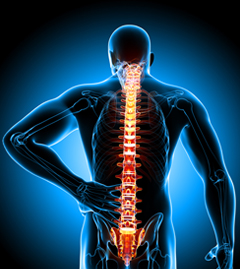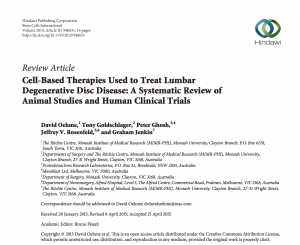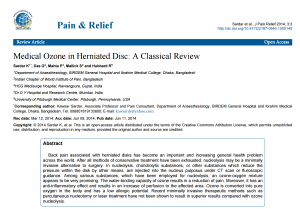Back pain

Back pain is one of the most common sources of pain, and can affect people of any age and gender, whether they obtain a back injury from a fall, or they suddenly wake up with it.
Sure, some of us have back aches for a couple of days and they go away, often from heavy lifting, or sleeping the wrong way, but there are others that face the chronic pain constantly and it prevents them from being able to do the simplest of tasks.
All portions of your back; lower, middle, and upper can experience pain separately or all at once, and the pain can vary from stabbing pain, to numbness, an inability to stand straight, and restricted mobility, among others.
Contact a doctor if your back pain:
- Is constant or intense, especially at night or when you lie down
- Spreads down one or both legs, especially if the pain extends below the knee
- Causes weakness, numbness or tingling in one or both legs
- Is accompanied by unexplained weight loss
- Occurs with swelling or redness on your back
Also, see your doctor if you start having back pain for the first time after age 50, or if you have a history of cancer, osteoporosis, steroid use, or drug or alcohol abuse.
Symptoms of back pain may include:
- Muscle ache
- Shooting or stabbing pain
- Pain that radiates down your leg
- Limited flexibility or range of motion of the back
- Inability to stand up straight
In some cases, back pain can signal a serious medical problem. Seek immediate care if your back pain:
- Causes new bowel or bladder problems
- Causes progressive weakness
- Is associated with pain or throbbing (pulsation) in the abdomen, or fever
- Follows a fall, blow to your back or other injury
Causes
Back pain often develops without a specific cause that your doctor can identify with a test or imaging study. Conditions commonly linked to back pain include:
- Muscle or ligament strain: Repeated heavy lifting or a sudden awkward movement may strain back muscles and spinal ligaments. If you’re in poor physical condition, constant strain on your back may cause painful muscle spasms.
- Bulging or ruptured disks: Disks act as cushions between the individual bones (vertebrae) in your spine. Sometimes, the soft material inside a disk may bulge out of place or rupture and press on a nerve. The presence of a bulging or ruptured disk on an X-ray doesn’t automatically equal back pain, though. Disk disease is often found incidentally; many people who don’t have back pain turn out to have bulging or ruptured disks when they undergo spine X-rays for some other reason.
- Arthritis: Osteoarthritis can affect the lower back. In some cases, arthritis in the spine can lead to a narrowing of the space around the spinal cord, a condition called spinal stenosis.
- Skeletal irregularities: Back pain can occur if your spine curves in an abnormal way. Scoliosis, a condition in which your spine curves to the side, also may lead to back pain, but generally only if the scoliosis is quite severe.
- Osteoporosis: Compression fractures of your spine’s vertebrae can occur if your bones become porous and brittle.
Diagnosis
During your initial visit with your doctor, you will undergo a complete evaluation to give the doctor the best chance at a proper diagnosis. A physician will be responsible for recording an in depth history, as well as carry out a thorough neurological workup and physical exam. If the doctor feels as though the problem is not solved, he or she will order further testing, scans or images to assist in the diagnosis.
Additional tests, scans or images may be ordered to diagnose the following:
- Herniated Disc
- Bulging Disc
- Spinal Stenosis
Diagnostic tests aren’t necessary to confirm the cause of your back pain. However, if you do see your doctor for back pain, he or she will examine your back and assess your ability to sit, stand, walk and lift your legs. Your doctor may also test your reflexes with a rubber reflex hammer.
These assessments help determine where the pain comes from, how much you can move before pain forces you to stop and whether you have muscle spasms. They will also help rule out more-serious causes of back pain.
If there is any reason to suspect a specific condition may be causing your back pain, your doctor may order one or more tests:
- X-ray. These images show the alignment of your bones and whether you have arthritis or broken bones. X-ray images won’t directly show problems with your spinal cord, muscles, nerves or disks.
- Magnetic resonance imaging (MRI) or computerized tomography (CT) scans. These scans can generate images that may reveal herniated disks or problems with bones, muscles, tissue, tendons, nerves, ligaments and blood vessels.
- Bone scan. In rare cases, your doctor may use a bone scan to look for bone tumors or compression fractures caused by osteoporosis.
- Nerve studies (electromyography, or EMG). This test measures the electrical impulses produced by the nerves and the responses of your muscles. This test can confirm nerve compression caused by herniated disks or narrowing of your spinal canal (spinal stenosis).
Treatment
In most cases, where back pain is at a moderate level, treatment most likely will involve a few weeks of in-home treatment, resting, and paying extra attention to it in order to impede the progress. While bed rest may seem to be the best thing for you in this case, it can actually cause your pain to get worse, it’s important to stay as active as you can without causing more pain. If the pain does not subside over the following weeks, contact your doctor for further treatment.
Medications
Pain relievers such as acetaminophen, which is equivalent to over the counter medicine Tylenol, or anti-inflammatory drugs, that are not steroids, including Ibuprofen or naproxen, may be mentioned by your doctor as the medication you should use to resolve your pain. If these medications do not have an impact on your pain, the doctor may consider muscle relaxants.
Studies have also shown that small amounts of antidepressants, specifically tricyclic antidepressants, have had a positive effect on chronic back pain.
Physical therapy and exercise
At the forefront of back pain treatment, physical therapy can work wonders for a person dealing with this condition. Treatments vary from utlrasound, electrical stimulation and muscle-release techniques that are applied to the specific area of pain. As the pain begins to minimize, you can continue the therapy and exercises at home with common stretching techniques that keep you flexible and strong, especially in your back and abdominal muscles.
Injections
When physical therapy and over the counter medications do not suffice, and the pain persists, as well as spreads down your leg, a doctor may go ahead and inject you with cortisone in the epidural area of your spinal cord. This will help decrease swelling around the nerve roots for a few months at a time.
Based on the doctor’s recommendations, you may also receive numbing medication along with the cortisone injected into the area of pain.
Surgery
One of the least common treatments one that occurs when the pain is severe, doesn’t diminish, spreads to the legs, and may even cause other muscles to go weak, is surgery. The doctor will do everything he or she can to avoid this treatment, and usually hold off on it for pain that is associated with structural anatomical problems that don’t show any improvements to the other treatments.
Alternative treatment
A number of alternative treatments are available that may help ease symptoms of back pain. Always discuss the benefits and risks with your doctor before starting any new alternative therapy.
- Chiropractic care. Back pain is one of the most common reasons that people see a chiropractor.
- Acupuncture. A practitioner of acupuncture inserts sterilized stainless steel needles into the skin at specific points on the body. Some people with low back pain report that acupuncture helps relieve their symptoms.
- Massage. If your back pain is caused by tense or overworked muscles, massage therapy may help.
- Yoga. There are several types of yoga, a broad discipline that involves practicing specific postures or poses, breathing exercises and relaxation techniques. Results of a few clinical trials suggest that yoga offers some benefit for people with back pain.
Related Research Articles
Title: Cell-Based Therapies Used to Treat Lumbar Degenerative Disc Disease: A Systematic Review of Animal Studies and Human Clinical Trials
Authors: David Oehme, Tony Goldschlager, Peter Ghosh, Jeffrey V. Rosenfeld, and Graham Jenkin
Journal: Stem Cells International
Title: Medical Ozone in Herniated Disc: A Classical Review
Authors: Sardar K, Das G, Mahta P, Mallick S and Hubbard R
Journal: Pain & Relief


